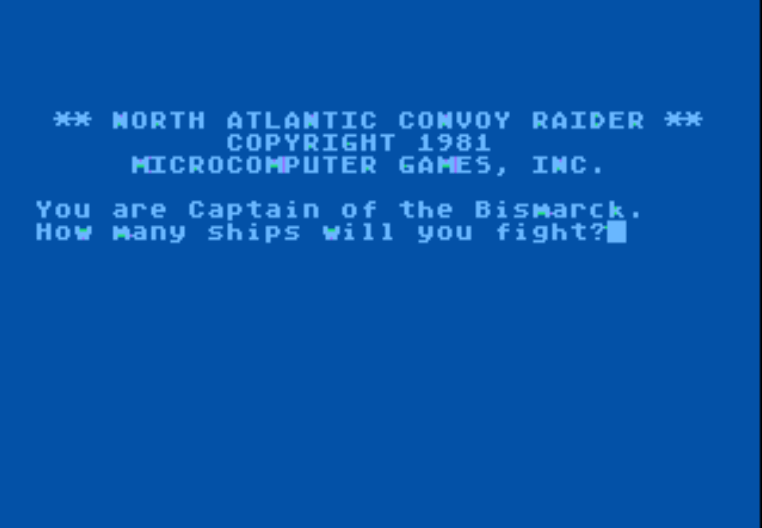
We will not stay forever in this fjord , Leutnant Narwhal. We need to make it to the Atlantic to destroy the convoys the allies rely on so much…
The entire British Navy will be looking for us, Admiral. Should we try the long route through the Greenland Sea or the shorter route between the British Isles and Iceland ?
According to the map, we could just sail through the British Isles !
You are right Admiral ! The British Isles appear to have disappeared entirely.
North Atlantic Convoy Raider is the third “Avalon Hill summer 1980 release” game I will cover and is about the chase for the Bismarck, making it the second game about this event out of five historical wargames released commercially at this time. At least, it will allow me to skip the historical introduction. Unlike Computer Bismarck, this game can only be played solo as the Germans, and more specifically as the Captain of the Bismarck (there is no Prinz Eugen this time).
I take command of my ship in Bergen, and I am informed of the English assets in the area :
- two fast battleships (the HMS Prince of Wales and the HMS King George V),
- two battleships (the HMS Ramilles and the HMS Rodney),
- two battlecruisers (the HMS Hood and HMS Repulse )
- one aircraft carrier (the HMS Victorious).

If you don’t know the difference,
- a battleship is powerful, but slow and heavily armored,
- a battlecruiser is almost as powerful as a battleship, but sacrifices armor for speed, and finally
- a fast battleship uses interwar technologies to combines the firepower and armor of a battleship and the speed of a battlecruiser, making the latter obsolete.
The Bismarck typically is a fast battleship. The different capabilities of the British ships are not explained anywhere in the game, but become obvious as you test the game.
The game opens with this screen (with my added legends) :

The game represents a space of roughly 2 000 square kilometers (based on how long it takes to cross it at 30 knots), which leaves one inescapable conclusion : the British Isles have disappeared, as mainland Scotland should be 600 km away from Bergen.
As for the ports, the Southernmost German Port is probably Bordeaux (1 800 km away as the crow flies), then Saint Nazaire (1550km away ) and Brest (1450 km away, but 200km from Saint Nazaire).
In any case, I decide to use the fog to go due West, bearing 270, to put some distance between my ship and Bergen. Unfortunately, the Bismarck pierced the fog around noon, and I suddenly discovered that I was being shadowed by the HMS Hood and the HMS Prince of Wales. Only the former was in range.
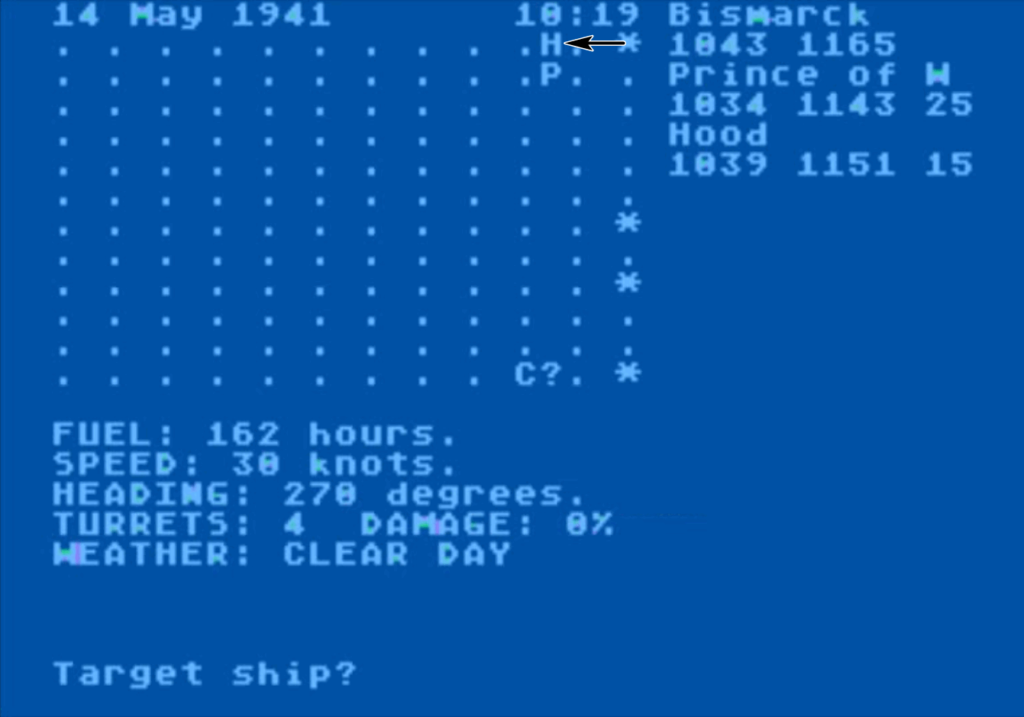
The HMS Hood is an old battlecruiser from WWI : fast, well-armed but weakly armored. She is way less powerful than the Bismarck, but of course lucky hits are always possible. In addition, should I be slowed down by the damage, the HMS Prince of Wales may catch up and that ship is modern, armored and powerful.
The gunnery battle begins :
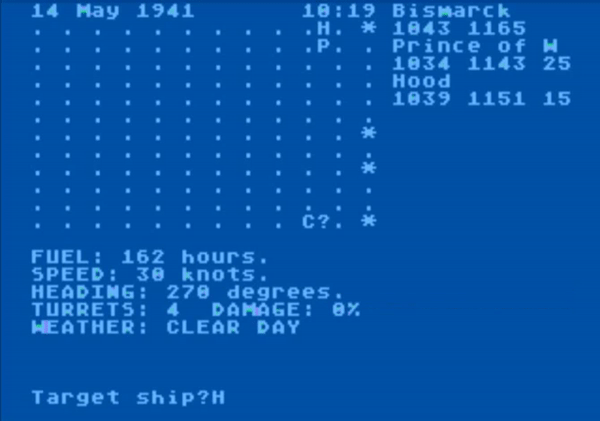
And the HMS Hood goes down without causing any significant damage to the Bismarck.
Immediately after the end of the combat and by mere chance, the Bismarck is engulfed again by fog. The HMS Prince of Wales had time to follow, and gets closer despite the fog…
… unfortunately for the HMS Prince of Wales, the Bismarck is able to see her without being seen (clearly the HMS Prince of Wales’ radar was malfunctioning !). Less than one hour after the destruction of the HMS Hood, the Bismarck devastates the HMS Prince of Wales without retaliation. The British battleship explodes, and sinks ! The Bismarck was not damaged.
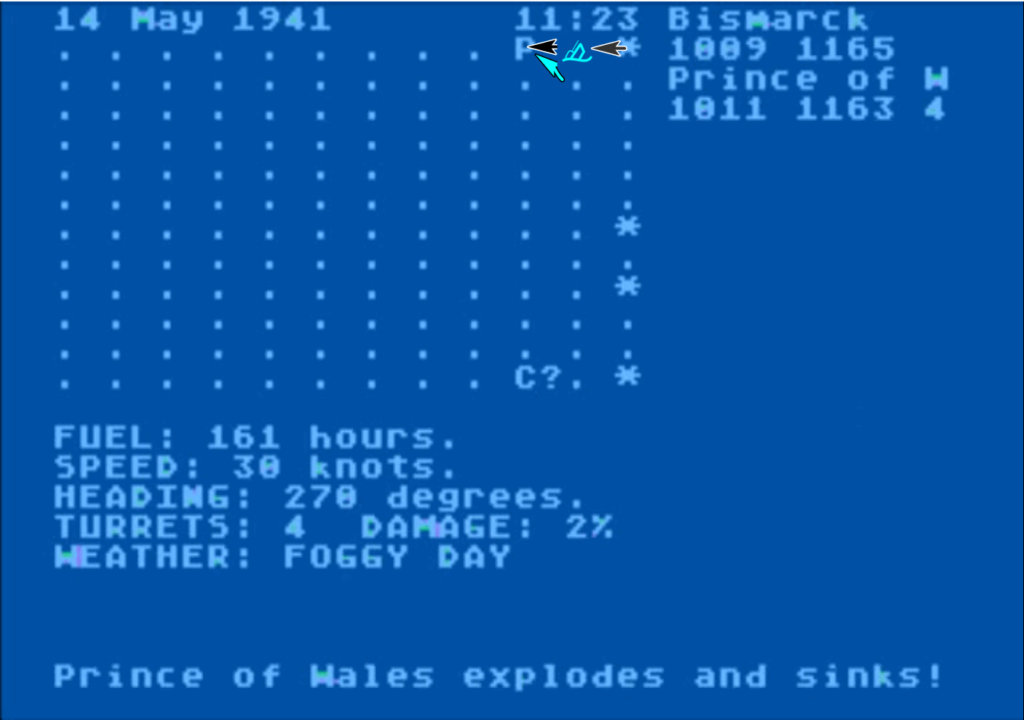
With her pursuers removed and hidden by the fog, the Bismarck carries on West. At nightfall, I order her to turn and head South West !

During the night, the Bismarck receives from submarines the location of at least three convoys. Sadly, the fog dissipates as the sun rises, but in theory the Brits are looking for me miles away.
Luckily, an allied convoy happens to be there, and it is dispersed. Unluckily, the HMS Rodney was patrolling North-East of the convoy, and we have the Royal Navy on us on us again :
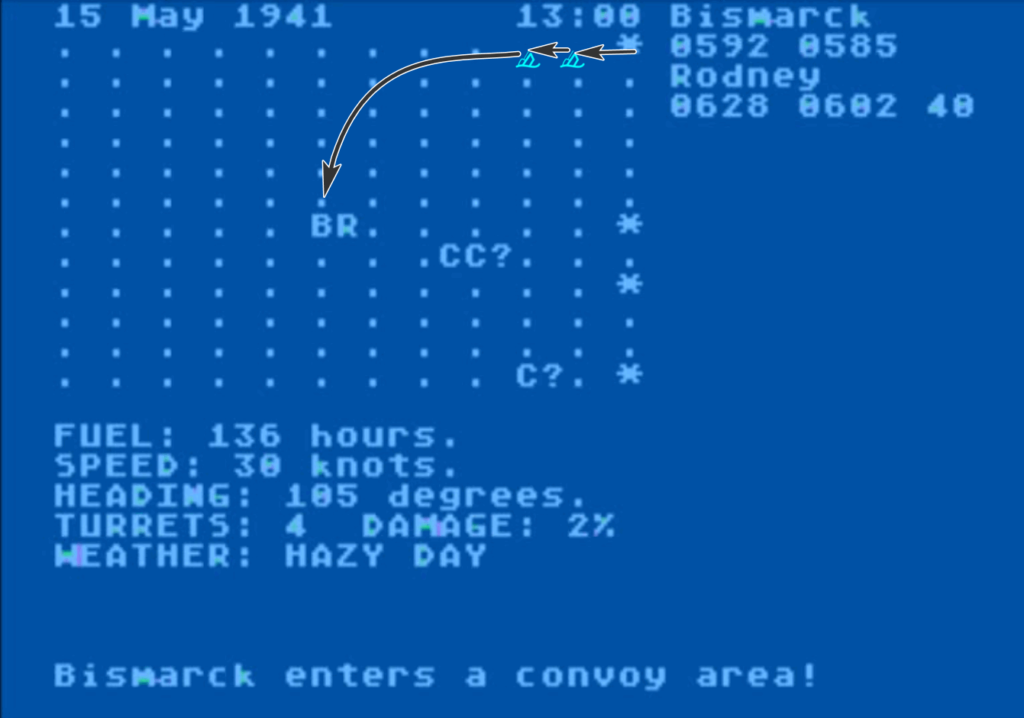

The HMS Rodney is an WWI battleship, much slower than the Bismarck, so I can just avoid it by passing South of her, then due East to reach the other convoys.

I now order the Bismarck full steam East, toward the convoy. The HMS Ramilles joins the chase, but she is as slow or slower than the HMS Rodney, so I am not worried. On the other end, a new convoy (or maybe the same) is detected a bit North of the position.
I use the night for a quick detour North to catch the convoy, which is dispersed like the previous one :

But as I return back South, there’s a surprise in store :

The HMS Rodney followed my last known heading, and my small detour North allowed her to catch up with me. Well, no biggies, I turn North to escape her… and meet the HMS Repulse who was arriving to support the HMS Rodney.
I am forced to turn East again, and for a short time I am in range of the HMS Rodney :
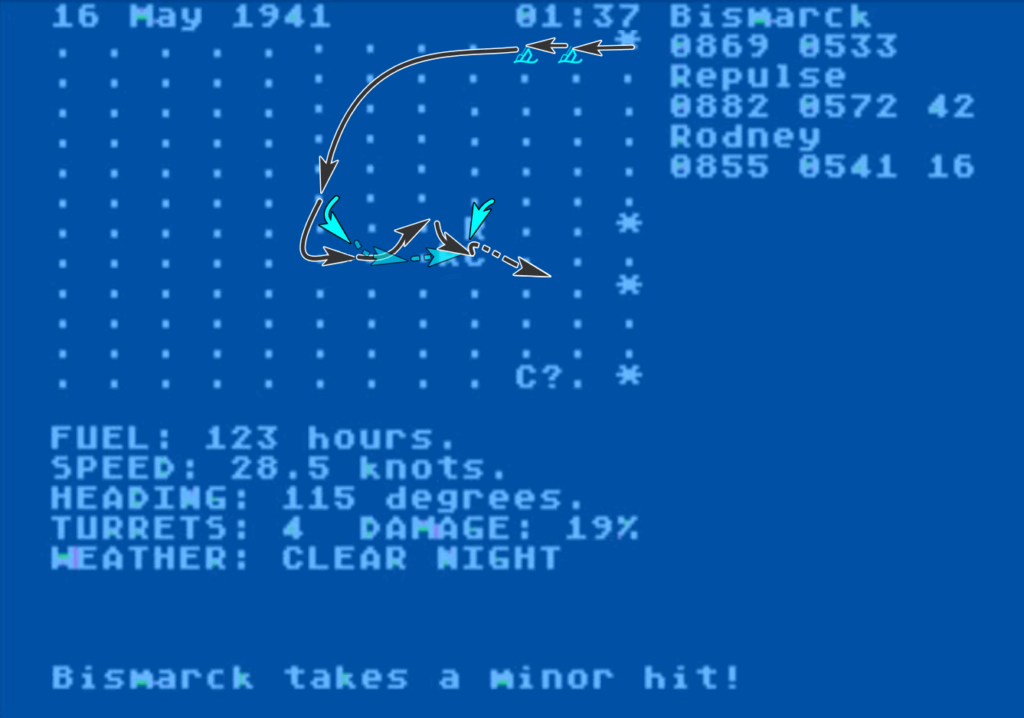
A short exchange of fire left me a bit damaged and a bit slower, but you should see the other guy! The HMS Rodney received some massive damage, and would not be seen again until the end of the campaign !
The problem is that HMS Repulse is a battlecruiser and as such, faster than me, especially since I am damaged. I now have a ship shadowing me.

I wait for the morning fog to set in, and I turn hard starboard, hoping to lose the HMS Repulse.
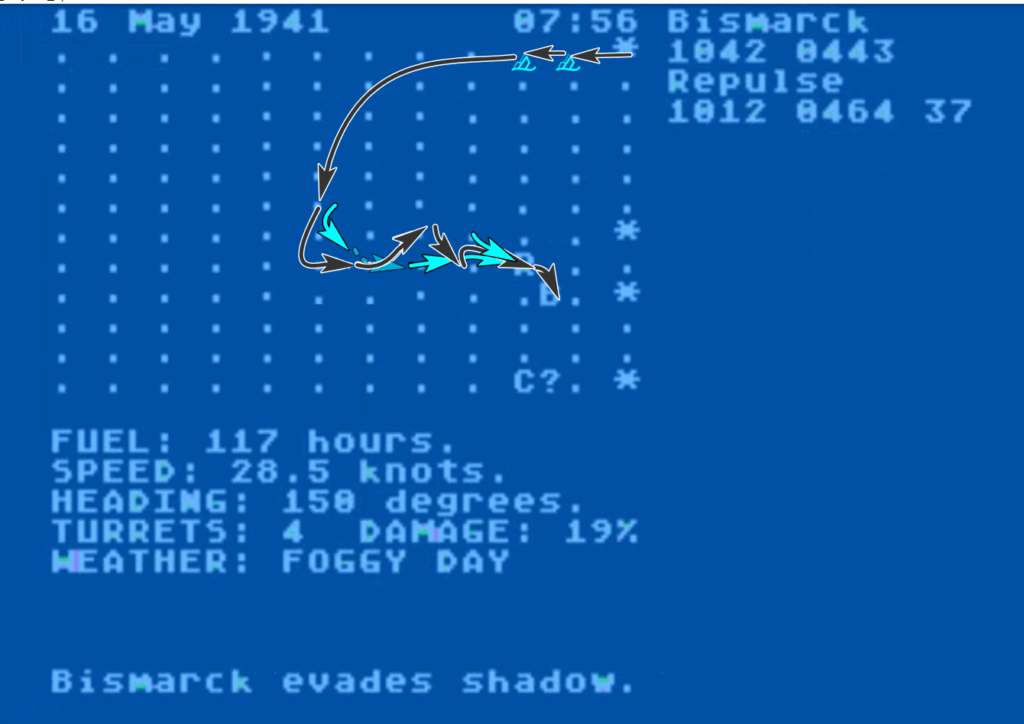
I am not sure whether the HMS Repulse saw me turning, but it proves irrelevant as soon as the fog clears :

Oh well, I am confident I should win a battle against her, so I will just check that last convoy’s position, then double-back, sink the Repulse and head home.

I cannot find the convoy, and head East again, fighting the HMS Repulse on the way :


The battle against the battlecruiser was harder than expected. It is destroyed, but I lost half my firepower, and more critically my speed is reduced to 18 knots. At least I am really close to Bordeaux, so let’s head there !

Suddenly :

No one expects the HMS King George and the HMS Ramilles ! With my speed of 18 knots, I cannot hope to outrun them, so I need to dash to the port. I am at X = 12.08, the port is considered reached at 12.50. It is night for one more hour, too!
But they caught up with me some 20 nautical miles from Bordeaux, and at only 4 nautical miles (roughly 7 km) from Bordeaux they deal the final blow :
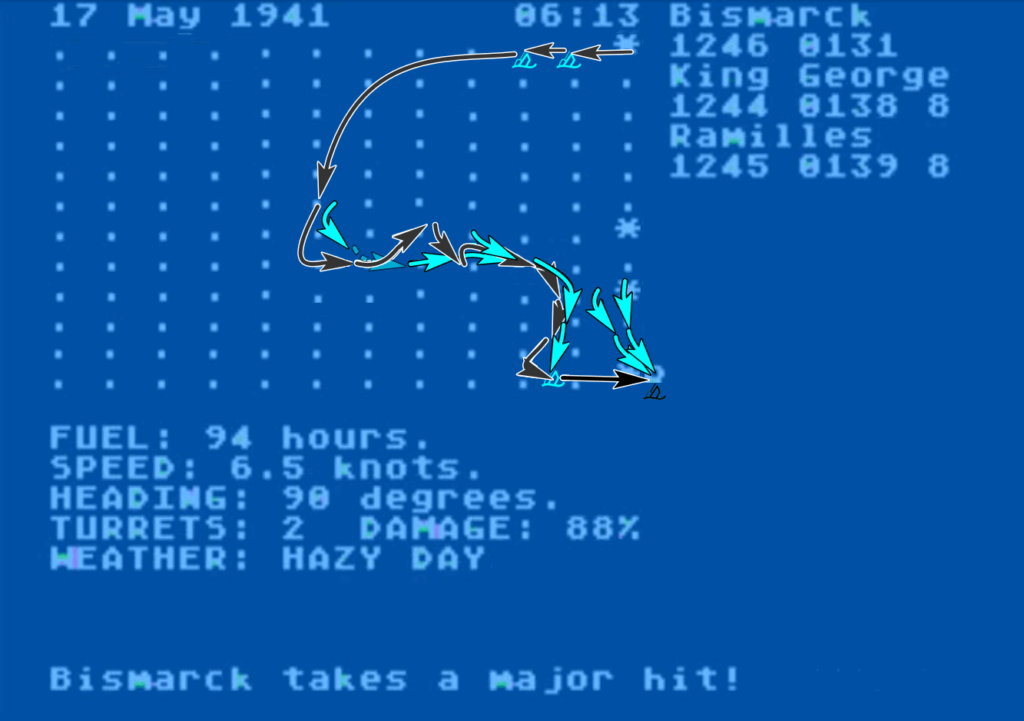
The Bismarck is sunk ! But her legacy will remain, and this sortie will be considered a victory for the Germans : two battlecruisers and one fast battleship has been lost by the Brits in her pursuit, another battleship has been damaged, and two convoys have been dispersed. I sure hope the submarines actually finished the job destroying the transport ships.

Ratings & Review

North Atlantic Convoy Raider by Avalon Hill, USA
First release : Summer 1980 on Apple II, Commodore PET, TRS-80
Tested on : Atari
Total Hours Tested : 2
Average duration of a battle : 5-10 minutes
Difficulty: Trivial (0/5)
Would recommend to a modern player : No
Would recommend to a designer : No
Final Rating: 19/100
North Atlantic Convoy Raider is the second entry in some 5 games to cover the hunt for the Bismarck. The approach is very different from Computer Bismarck, but also from the one chosen in Midway Campaign. Instead of trying to simulate the chase in detail, the designers focused on the key-elements (the very large territory covered by the chase, the impact of the weather on visibility, the day/night cycle) and made an action-focused game out of that – by the time it takes to run one turn in Computer Bismarck, I could have played a whole game of North Atlantic Convoy Raider start to finish.
A. Settings & Aesthetics
There is only the bare minimum in the game in terms of realism. The map is as simple as possible, to the point of making the United Kingdom disappear. The game is also devoid of cruisers (including the Prinz Eugen) or other support ships.
There are a few hints that this is more a technical limitation than the desire of the developers. The British ships are patrolling in pairs as historically (eg the Hood and the Prince of Wales are together, and similarly the King George V is with the Victorious) ; I am also convinced that the ships also have different, “historical” statistics though given the limited feedback the game gives I cannot exclude I am convincing myself of that.
The manual is minimalist, and unlike Midway Campaign does not even include a historical section.
There are no graphics.
Score : 2/20
B. UI , Clarity of rules and outcomes
Midway Campaign had 6 commands, North Atlantic Convoy Reader has two : bearing when out of combat, and what the player shoots at during combat. At least it makes the UI easy to understand.
The combats are extremely simple : you get as many “attacks” as you have turrets and the closer the target the higher the chance to hit. Combat against the same ship in two different tests could give fairly different outcomes, but that is the rule of naval warfare.
A few important pieces of information are missing, even in the manual : range of the guns, distance of sight, … For such a simple game, not having that basic information is hard to forgive.
Score : 4/20
C. Systems
The strategic layer consists of steering the ship to avoid the enemy forces. There is some subtlety to this, but the player is still incredibly exposed to the randomness of the weather and of enemy random air searches.
The tactical layer consists of choosing the target for your guns. In general, there is only one target, and when there are several the situation can be considered pretty dire. There is no subtlety in this.
Score : 3/20
D. Scenario design & Balancing
There is only one scenario and the enemy ships always start at the same position. At least the randomness of the weather ensures some variability, though I cannot give much credit for “scenario design” when the game is so simple to start with.
You can choose the difficulty. At the minimum difficulty, it is possible to sink all the British capital ships, and then raid the convoy until the Bismarck runs out of fuel. At maximum difficult (9 British ships), I never managed to reach the convoy, as you are harassed non-stop by the British torpedo bombers from the moment you are detected. The game feels balanced and kinda works at 6 – 7 hostile capital ships .
Score : 5/20
E. “Fun” and Replayability
The game has action packed playing sessions, so it is quite fun to pick-up for a quick run. Still, the game is obviously very limited, and quickly repetitive.
Score : 5/20
F. Final rating
19/100, which is a bit above Midway Campaign since the player has some agency on the outcome, and because two different runs will play a bit differently.
Overall, the game feels more like an arcade game with a naval theme than a wargame
Contemporary reviews
North Atlantic Convoy Raider reception was chilly : it was at best ignored, and the few reviews were short and negative. Creative Computing in June 1981 reviewed all the Avalon Hill summer 1980 games and stated that they collectively “fall short as computer games”. Space Gamer said in January 1981 that the game is expensive for what it is (“a $10 price tag would have been more in line for what you get“).
In France, this was only briefly covered by Tilt in its 1983 wargame retrospective, where it received the worst possible rating: 1/6